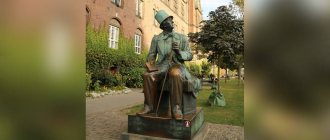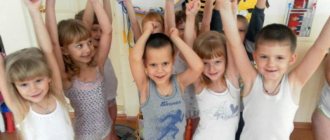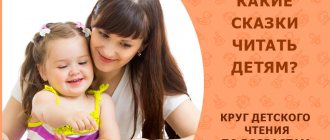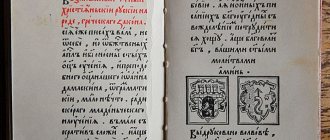Fairy tales for preschoolers and first graders
In addition to the educational effect, a fairy tale develops the emotional sphere of a child, immersing him in a world of vivid experiences and joy. It becomes interesting for the child to portray an angry bear or a frightened mouse, a joyful squirrel or a sad bunny. In the future, this helps him understand people’s feelings and make friends. The magical world of fairy tales develops the child's imagination. But a creative approach and the ability to solve non-standard problems are also valued among adults. A fairy tale helps to connect with the roots of one’s people, develops speech, thinking, imagination, and ultimately, this is the basis for the further development of intelligence.
Fairy tales for kids
Fairy tales for preschool children are very simple, but they begin to understand what courage and cowardice, friendship and betrayal are.
For example, the Russian folk tale “Zayushkina’s Hut” fosters responsiveness and compassion, teaches children to support each other and help out in difficulties. In the collections of Russian folk tales, children will be met by characters familiar to everyone: Princess Nesmeyana and Vasilisa, Sivka the Burka and the swan geese, sister Alyonushka and brother Ivanushka. And in the book “Wonderful miracle, wondrous miracle. Russian folk tales from A to Z”, the child will get acquainted not only with fairy-tale characters, but will also see the originally designed Old Church Slavonic alphabet. Of course, it is not only folk tales that teach good things. It is also interesting for kids to listen to original works, for example, by S. Mikhalkov, V. Oseeva and other domestic writers in the collection “Tales of Kindness”. The book will be useful not only for children: it contains tips for parents from fairytale therapist Irina Tereneva. Tips from the same psychologist can be found in another collection - “The Best Fairy Tales for Boys. With simple tips for smart parents." The book contains both folk and original fairy tales. And the recommendations of a fairytale therapist on the issues of raising boys, first falling in love, and the tears of persistent boys will be useful for mothers and fathers. The wonderful fairy tale by British writer Holly Webb “Freckle the Kitten, or How to Learn to Help” tells about the kind Edie. The girl picked up a kitten on the street and is learning to take care of it: feed it with special food, make sure that Freckle doesn’t get cold or overheat, and do other small things so that her favorite little animal can get out. Surely after reading this fairy tale, the baby will want to have a pet.
Fairy tales should definitely be discussed with your child. The colorful guide “Games with Fairy Tales” will help with this. The first part, “Listen and Understand,” is designed for children aged 3-5 years, the second book, “Listen and Reason,” is intended for older preschoolers. The manual includes interesting stories and game tasks that in a simple form develop children's thinking, imagination, text listening skills and dialogical speech. In both parts of “Games with Fairy Tales,” children meet cross-cutting characters both in stories and in tasks for the text.
The textbook “Traveling through Fairy Tales” for children 4-7 years old (authors N.G. Salmina, O.G. Filimonova) includes tasks based on fairy tales familiar to children. For example, you need to think about which magical objects perform the same actions, and correlate the actions and characters of fairy-tale characters. Such exercises help not only the development of speech, thinking, attention and imagination, but also form an understanding of norms of behavior and morality. When teaching children English, you can use the electronic manual for preschoolers “Far and Near. We read fairy tales in English. For children 5-7 years old." It includes 6 adapted fairy tales of different nations in English and Russian. Colorful illustrations and accessible tasks will strengthen the child’s interest in a foreign language.
Fairy tales for future first-graders
Be sure to read to children the works of famous children's writers: S. Baruzdin, V. Golyavkin, S. Marshak, I. Tokmakova, G. Oster, V. Suteev, G. Tsyferov.
Children will encounter their works in the Primer of the textbook system of the educational and methodological complex “Primary School of the 21st Century”. Do you remember the good fairy tale by V. Suteev “The Magic Wand”? The Hare saw the Hedgehog holding a stick and was surprised:
“Why do you need a stick?” What's the use of it? “This stick is not simple,” explained the Hedgehog. - This is a lifesaver. The hare only snorted in response. They went further and reached a stream. The hare jumped over the stream in one jump and shouted from the other bank: “Hey, Prickly Head, throw away your stick, you won’t get across here with it!” The Hedgehog did not answer anything, stepped back a little, ran up, stuck a stick in the middle of the stream as he ran, flew to the other bank in one fell swoop and stood next to the Hare as if nothing had happened. The hare even opened his mouth in surprise: “It turns out you’re jumping great!” “I don’t know how to jump at all,” said the Hedgehog, “this is a lifesaver - the jump rope helped me through everything.” In the end, it turns out that the matter is not only in the wand, but also in resourcefulness and ingenuity.
After reading, discuss with your child in what other cases the wand will help and how to get out of difficult situations in other ways. And if you loved reading about the French dog Pif as a child, then be sure to show your children G. Oster’s book “All the Adventures of Pif.” The baby will laugh while listening to stories about the resilient four-legged animal and looking at the bright illustrations! The cheerful book by I. Tokmakova “Alya, Klyaksich and the letter A” will tell about the journey of Ali and her assistant, the letter “A”, through the ABC. The letter “A” suffers: “The disgusting Klyaksich made his way into the ABC! He quarrels between letters, he hates them, he wants to replace them all with his relatives - blots. He has already kicked me out, and now in my place stands a fat blob - his niece.” The girl must save the letters! The young reader will help complete the mission by solving various tasks. He will “repair” the railroad, which was dismantled by the harmful Klyaksich, count forward and backward, draw Christmas trees, decipher the enchanted inscription... With this fairy tale, the future first-grader will better remember letters, develop fine motor skills and - most importantly - become interested in learning the alphabet and reading.
Fairy tales for first-graders help them successfully adapt to school. A good example is the collection of fairy tales by M. Panfilova “Forest School”. The book will introduce the children to Teacher Hedgehog and his students - forest animals. In fairy tales, animals learn to study and make friends, do homework and maintain discipline, overcome laziness and make peace after a quarrel.
- A. Aleksin “In the land of eternal vacations”
. Any first-grader will first be happy for the boy Petya, who has found himself in the land of eternal vacation. There you can relax, have fun, eat sweets and watch movies all the time. But then the child will understand that this way of life is boring: “I could no longer eat gingerbread, marshmallows and chocolate... How I now dreamed of simple black bread! Or about potatoes with fried sausage! Petya got tired of idleness and ran away from the kind Father Frost and Snow Maiden, who fulfill all wishes, to school.
Primer. 1 class. Textbook in 2 parts. Part I
A.O. Evdokimova, L.E. Zhurova
The textbook and three workbooks included in the teaching and learning system “Primary School of the XXI Century” constitute a complete set of materials for teaching first-graders literacy, reading and writing.
Buy
In addition, you can read fairy tales for first-graders that will help schoolchildren overcome school fears and increase educational motivation:
- E. Uspensky “Uncle Fyodor goes to school
. The book talks about the difficulties a future first-grader may encounter and how the well-known boy copes with them. It's funny that Postman Pechkin, with whom the adventures happen, is also getting ready to go to school.
- L. Geraskina “In the land of unlearned lessons”
. The slacker and ignorant Vitya Perestukin had no idea how school knowledge is needed in ordinary life! Traveling with him through the Land of Unlearned Lessons, the first grader will understand that a person’s life depends on a single comma and that perseverance and perseverance are needed in life, while laziness and lack of commitment prevent one from achieving success.
And as bedtime stories for first-graders and preschoolers, you can choose the collection “Good Tales.
With simple tips for your beloved grandmothers." After a difficult school day, your child will be pleased to listen to fairy tales and complete interesting tasks: play finger games, repeat tongue twisters, solve riddles. This will relax the child and harmonize his emotional state. For example, the fairy tale “The Cuckoo Clock” by S. Prokofieva will help a child wake up joyfully in the morning and follow a daily routine, which is very important for both preschoolers and schoolchildren. I would like to highlight tales about animals separately. These books not only help children develop courage, kindness, compassion and confidence. In them, the child learns about the habits of animals, birds and insects, about their way of life. It is better to start introducing a child to the world of animals and plants with the works of V. Bianchi. His stories and fairy tales in the book “Forest Newspaper” will show that a lot of interesting things happen in the forest. That's why the animals and birds decided to publish a newspaper so that everyone would know about the interesting events of the forest inhabitants. By reading all 12 issues, children will learn about natural phenomena, the life of plants and animals. By discussing riddle questions with your child, you will instill in him a love for nature.
The classic children's fairy tale by D. Mamin-Sibiryak “The Gray Neck” tells about the life of a flock of ducks and the friendship of a duck and a hare, how they were able to resist the treacherous fox. And delightful descriptions of nature will instill love for your native land:
The mountains seemed higher, as they do at night. The high month bathed everything in its tremulous sparkling light. The mountain river, seething during the day, calmed down, and the cold quietly crept up on it, hugged the proud, rebellious beauty tightly and as if covered it with mirror glass.
Ian Lari’s work “The Extraordinary Adventures of Karik and Valya” will tell you that “in this amazing world you can meet even stranger creatures. And these are not monsters from the fairy tales of Andersen and the Brothers Grimm. They all live next to us, in a wonderful fairy tale called “life.”
.
And we will talk about the life of ordinary insects. And young readers will understand: “a man is great not in height, but in his mind”
and
“knowledge is stronger than all explosives
.
Children grow up, and books grow up with them. Fairy tales for elementary school children become more serious. After first grade, your child can be introduced to the book “The Little Prince”. Quotes from Exupery's work are still relevant:
- There is such a firm rule. Get up in the morning, wash your face, put yourself in order - and immediately put your planet in order.
- Adults never understand anything themselves, and for children it is very tiring to endlessly explain and explain everything to them.
- People no longer have enough time to learn anything. They buy things ready-made in stores. But there are no such shops where friends would trade, and therefore people no longer have friends.
Perhaps only the fairy tales of Saltykov-Shchedrin can compare with the depth of the philosophy of the Little Prince - irony over the structure of life.
After reading these works, the student will want to return to them later - both French and Russian writers are always relevant. Even a primary school student will understand the meaning of M. Saltykov-Shchedrin’s fairy tale “Kisel”: it is important to appreciate what you have and not to chase after overseas exoticism. And you can get acquainted with ancient myths and ancient legends by reading the popular series “The Chronicles of Narnia” by Clive S. Lewis. Once in a country that only children and people with a pure heart and soul can see, the student will once again understand how important it is for good to defeat evil, and that he, too, helps this with his ordinary actions. To develop creativity, confidence, the ability to behave in public, and team building, it is useful to read fairy tales for elementary school children. These can be both original fairy tales and fairy tales in a new way. Let's say you can invite your child and his classmates to compose different versions of the fairy tale "Little Red Riding Hood." The class is divided into three teams, one of which puts on a horror film, the second - a comedy, and the third - an action movie with a police chase. Let students find props, costumes and come up with a script on their own. Children and parents are guaranteed fun and creativity!
Fairy tales can be different. Be sure to introduce children to magical works!
Stories must be told quietly.
With arrangement. Not in any hurry. So that the soul has time to believe in a good ending, and not a dashing one ...
(S. Ostrovsky)
Olga Ivanova
The first books for independent reading (after the primer or during its development)
Hi all!
Today I have prepared a review of books (as well as series of books) from which our 4-5 year old children will be able to acquire their very first reading skills. First books for independent reading
It is very important to choose the right one - your choice will directly determine whether your child will love reading, whether it will be easy for him, and in the long term this will affect his studies at school!
So, let's look through the pages of such books!!!
In this post we will look at books of 3 categories:
1. Specially published books for the first independent reading WITHOUT_DIVIDING_WORDS_INTO_SYLLABLES;
2. Specially published books for the first independent reading WITH_DIVIDING_WORDS_INTO_SYLLABLES;
3. Books that were not published specifically for independent reading, but are quite suitable for these purposes.
I will also list the main characteristics by which I myself tried to choose books for my daughter’s FIRST INDEPENDENT reading.
(sometimes, however, she departed from them a little):
1. The text of the book must be printed in large font
Some people are skeptical about this point, but I have personally seen that with such a font, reading is easier for children - my daughter told me about this herself!
2. White background is welcome!
Everything is obvious here - the darker, brighter and more colorful the background - the more difficult it is to read.
3. Short stories with little text per page
The child must see and “feel” that the text is not endless and is within his capabilities.
4. Words and sentences from them should also be short at first
We will complicate things, but not right away 
5. Pleasant illustrations must be present
Don't forget that reading at this age is a game!
6. Preference for thin books
Practical point - it is more convenient for a child to hold and, in principle, interact with a book;
Psychological moment - increased self-esteem - “I read the whole book MYSELF!”
7. Interesting plot (simply super if it resonates with the interests of the child)
Reading should be fun and bring joy! Then you won’t have to further motivate the child.
==
I will assign a rating to each book (series of books) that will be discussed in the review based on all of the above characteristics. The more criteria a book meets, the higher the score. Thus, the highest score will be 7 points.
BOOKS WITHOUT DIVIDING WORDS INTO SYLLABLES
1. “Whose side” series from Tatyana Russita (super - score 7 out of 7)
The series of 8 books is incredibly fun and mischievous. I can’t imagine any child who wouldn’t like these books—I just can’t!!! Eh, why wasn’t she there when we were learning to put letters into words...
Series of books “Whose Side?” in the Labyrinth, My-shop, Ozone, Read.ru
2. Books about Pip from the “Easy to Read” series (score 7 out of 7)
At the moment, the series consists of 2 issues (2 levels of difficulty), each of which contains 4 books for reading and 1 for entertainment. Pictured are those for reading
Pictured are those for reading
Start with the first (blue) issue - Pip and his friends.
“Just Read” series about Pip in the Labyrinth, My-shop (1 and), Ozone, Read.ru
3. Developmental course series “Reading after the ABC book” (score 7 out of 7)
A series of 3 books of varying degrees of difficulty. Let's start with green!
Series “Reading after the primer” in the Labyrinth, My-shop (, and), Ozone
4. Series “Short stories for independent reading” (score 7 out of 7)
Consists of 4 books (the last one is not in the photo), also of varying degrees of complexity.
We start with “Tanya is still small” from the stories of L.N. Tolstoy.
Series “Short stories for independent reading” in Labyrinth, My-shop (, , ,), Ozone (and), Read.ru (, , , )
ATTENTION!
All 4 books in the “Short Stories for Independent Reading” series under one hard cover can be bought in this edition (the stories and pictures are 90% duplicated - there are a little more of them in the thin ones):
The book “First books on reading” in the Labyrinth, My-shop, Ozone, Read.ru
5. Series “Reading after the primer” (rating 5 out of 7
— reduced for font size and size of some stories).
The texts in the series are very different, see the photos in the Labyrinth for each book!!!
Series “Reading after the primer” in the Labyrinth, My-shop, Ozone, Read.ru
6. Series “I can read. Short Stories" (rating 6 out of 7
- reduced for some bad background)
The texts in the series are very different, see the photos in the Labyrinth for each book!!!
Series “I can read. Short stories" in Labyrinth, My-shop, Ozone
===
AND NOW BOOKS THAT ARE NOT INTENDED FOR INDEPENDENT READING, BUT ARE VERY SUITABLE FOR IT
7. The fox and the mouse are just perfect! (score 7+ out of 7)
This book is ideal for our purposes. Moreover, you can beat her and read her roles!!!
Book “The Fox and the Mouse” in the Labyrinth, My-shop, Ozone
8. A series of books about Masha (score 6 out of 7
— reduced a little due to the small font)
Series about Masha in the Labyrinth, My-shop, Ozone, Read.ru
9. Series about the Mouse (score 6 out of 7
- reduced for background)
The books in this series, it seems to me, are very close in content to the lives of our children, and this is their main charm.
Series about the Mouse in the Labyrinth, My-shop (, , , ), Ozone, Read.ru
10. Series “Little Tales” (score 6 out of 7
- reduced for content)
11. Series about Meowli (score 6 out of 7
- reduced for content)
Series about Meowli in the Labyrinth, My-shop, Ozone and Read.ru
12. Series about Shmyak (score 6 out of 7)
Personally, my child squeals with delight at books about Shmyak and reads them to me with particular pleasure :)))
Series about Shmyak in the Labyrinth from Rob Scotton and in the Labyrinth from Lin Shu, My-shop, Ozone 1st series and Ozone 2nd series, and Read.ru
Books about Shmyak were marked by the publishing house Klever with this icon
:
Please note that Clover also marked these (and many other) books with the “I Read Myself” icon (PICTURES ARE CLICKABLE):
In addition, recently a series of books have appeared in other publishing houses, which, in my opinion, should also be well suited for the first independent reading. Here are some of them (PICTURES ARE CLICKABLE!):
===
Let's move on to BOOKS WITH DIVISION INTO SYLLABLES
We have very few such books at home. I heard that experts advise children who have trouble understanding the division of words into syllables to read just such books. But in my opinion this does not apply to my child. On the contrary, it seemed to me that in such texts my daughter is less able to navigate where one word ends and another begins. Therefore, quite quickly we turned off “our reading by syllables” and moved on to the more standard books mentioned above. However, I will still note a couple of series with division into syllables that I liked.
13. Series “First reading. Reading syllable by syllable" (score 6 out of 7)
This series includes books with both short stories and long ones. We didn’t get to the long ones, moving on to the classic texts.
We start the series with the Jolly Farmer!
The texts in the series are very different, see the photos in the Labyrinth for each book!!!
The entire series “First Reading. Reading syllable by syllable" in Labyrinth, My-shop, Read.ru
14. Series “Reading by syllables” from the publishing house AST (score 6 out of 7)
The series features classic poems and fairy tales that your baby has probably already heard before - the easier it will be for him to read them 
Series “Read by syllables” from the publishing house AST in Labyrinth, Ozone
We will also talk about more serious thick books on which our children will improve their first reading skills (such as Kwak and Toad), but a little later - in subsequent posts.
==
I have a question for mothers of children who are already reading: what first reading books were hits with your child? Share!







